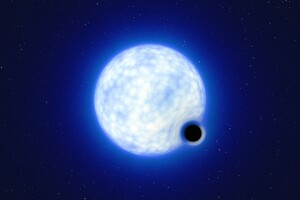But earthlings have nothing to worry about.

Scientists discovered a new black hole closest to Earth, which received the designation Gaia BH1. According to CNET, the black hole is 10 times larger than the Sun, it is located at a distance of 1,600 light years from us in the constellation Ophiuchus.
According to the researchers, the object is located three times closer to us than the previous one the record holder is a black hole from the constellation of the Unicorn. Gaia BH1 is close enough that the National Science Foundation's NOIRLab Astronomy Center says it's “in our cosmic backyard.”
Also read: Astronomers find evidence of giant ocean on Mars
“Although there have been many claims of the discovery of such systems, almost all of these discoveries have subsequently been disproved. This is the first unequivocal detection of a Sun-like star in a wide orbit around a stellar-mass black hole in our galaxy,” said astrophysicist Karim El-Badri.
Such black holes are 5-100 times more massive than our Sun. They are much smaller than the supermassive black holes that are located in the centers of galaxies.
The Gaia observatory of the European Space Agency catalogs the stars that are located in the Milky Way. The researchers studied the Gaia data and noticed in them a star similar to the Sun, which moved with characteristic “twitches”. The object that “pulled” it turned out to be a black hole.
Sleeping black holes are difficult to detect because they do not reveal themselves by emitting cosmic jets. Gaia BH1 was discovered thanks to the observatory's ability to track the star's position with high precision. This position changes as the star moves around the black hole.
But the Gaia research was just the beginning. Scientists turned to other telescopes to confirm the discovery. Using the Gemini North telescope, they were able to make precise measurements of the orbit of the observed star.
“We could not find a plausible astrophysical scenario that could explain the orbit of the observed system, in which there was not at least b of a single black hole,” El-Badri said.
Such black holes form as a result of the collapse of a massive star, so Gaia BH1 and its companion star form a binary system. But how this system was formed and evolved remains a mystery to scientists. According to them, the black hole differs from other known similar objects, its appearance cannot be explained by standard models of binary evolution.
Related video
Earlier astronomers using the Very Large Telescope found six galaxies that surround supermassive black hole. The discovery will allow scientists to understand how supermassive black holes could form and reach colossal sizes in a short time.




